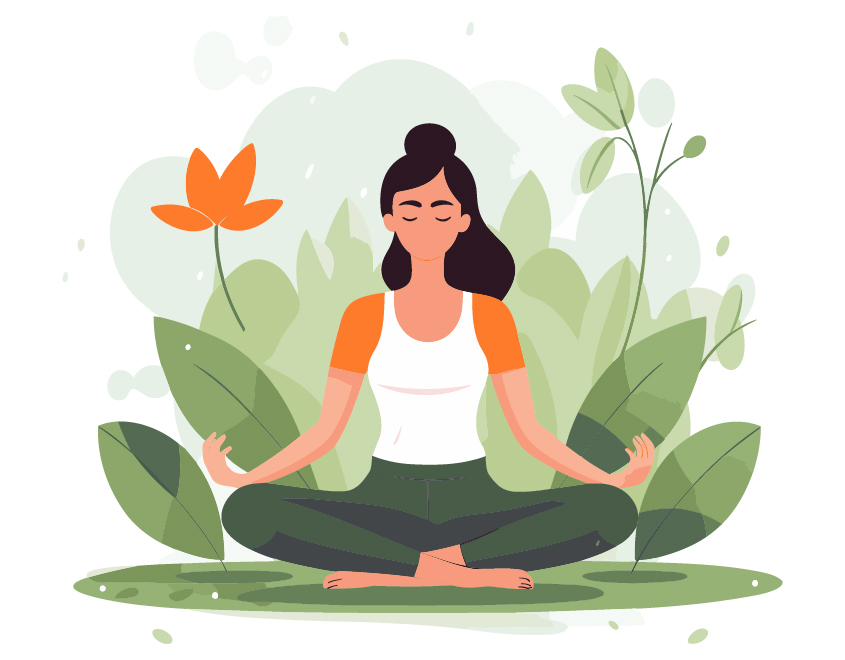
I. Introduction: Yoga – More Than Just Physical Fitness
Yoga is universal — it can be practiced anywhere, at any time, and by anyone irrespective of age, gender, culture, or nationality. It serves as a powerful tool for individuals, communities, and countries to improve both mental and physical health. The purpose of this day is to raise awareness about the holistic advantages that yoga offers for our well-being. It emphasizes the importance of finding balance in our fast-paced lives and encourages harmony in our physical, mental, and spiritual aspects.
In addition,we celebrate World Yoga Day on June 21st, a global event that highlights the importance of yoga in promoting holistic health and well-being. This day serves as a reminder of the profound impact yoga can have on our lives, encouraging individuals and communities worldwide to embrace yoga. It inspires and motivates millions to join in and practice daily. For many, these routines are a great way to connect the mind, body, and soul in a way that has existed for centuries.
Yoga, with its deep roots in Indian philosophy, is more than mere physical exercise. It encompasses a comprehensive system that works on multiple levels. Beyond physical exercise, it integrates the mind, body, and spirit, offering a path to overall health and inner peace. Its practice includes a variety of techniques such as postures (asanas), breathing exercises (pranayama), and meditation, each contributing to a balanced lifestyle.
As we give importance to yoga worldwide, the integration of yoga into students is equally important. Students have the pressure to excel academically and the constant barrage of information can be overwhelming, making it essential to adopt practices that support mental health and cognitive performance. Yoga, with its proven benefits, stands out as a valuable tool in this regard, offering students a natural and effective way to boost their cognitive abilities and overall well-being.
Here’s Why Yoga is Much More Than Just a Workout:
a. Mental and Emotional Well-Being:
- Yoga reduces stress and anxiety.
- Enhances mental clarity and focus.
- Promotes self-awareness and relaxation.
- Practices like Yoga Nidra aid stress reduction and emotional healing.
b. Physical Benefits:
- Yoga enhances flexibility, improves posture, and boosts circulation.
- It builds strength and supports overall physical health.
- Yoga improves balance and coordination.
- It balances hormones and supports digestive health.
- Yoga promotes restful sleep.
c. Cognitive Function:
- Yoga significantly improves cognitive function, enhancing memory, reasoning, and focus.
- It complements traditional medical treatments for various health conditions.
d. Accessibility:
- Regardless of age or physical ability, you can practice yoga. No special equipment is needed; it can be done anywhere.
e. Cost-Effective Wellness:
- Yoga saves on medical costs, as practitioners use fewer medical services.
II. Top Asanas for Brainpower
Cognitive function, which includes memory, reasoning, and focus, is crucial for students navigating the demands of their academic environment. Adequate blood flow to the brain and the ability to maintain focused attention are key components of optimal cognitive performance. The cognitive function relies heavily on adequate blood flow and the ability to maintain focus. Proper circulation ensures that the brain receives the oxygen and nutrients it needs to operate efficiently, while focused attention enhances the capacity for learning and problem-solving. Certain yoga asanas (postures) are particularly effective in boosting brainpower by improving blood circulation to the brain and promoting mental clarity and concentration.
a. Vrikshasana (Tree Pose)
- Description: Stand on one leg, with the other foot placed on the inner thigh of the standing leg. Hands are brought together in a prayer position or raised above the head.
- Benefit: Improves balance, concentration, and mental focus. The pose encourages calmness and helps center the mind, making it easier to concentrate on tasks.
b. Padmasana (Lotus Pose)
- Description: Sit with legs crossed, each foot resting on the opposite thigh, forming a criss cross position. Hands rest on the knees, palms up, often with the thumb and index finger touching.
- Benefit: Promotes calmness, enhances focus, and stimulates the brain. It helps to calm the mind, reducing mental chatter and enhancing the ability to focus.
c. Sarvangasana (Shoulderstand Pose)
- Description: Lie on your back and lift your legs and torso upwards, supporting your back with your hands, so your body forms a straight line from shoulders to feet.
- Benefit: Increases blood flow to the brain, improves thyroid function, and reduces stress. This enhanced circulation can improve memory and cognitive function, while also promoting a sense of mental clarity.
d. Bhramari Pranayama (Bee Breath)
- Description: Sit in a comfortable position, close your eyes, and place your index fingers on your ears. Inhale deeply and, while exhaling, make a humming sound similar to a bee.
- Benefit: Reduces stress, calms the mind, and enhances focus. The vibration produced during this practice can soothe the mind, reduce anxiety, and enhance concentration.
e. Suryanamaskar (Sun Salutations)
- Description: A sequence of twelve yoga poses performed in a flowing series. Each movement is coordinated with breath, creating a dynamic practice.
- Benefit: Enhances overall well-being, increases blood circulation, and provides mental clarity. This sequence promotes flexibility, strength, and improved circulation, while the rhythmic flow of the poses can lead to a meditative state, enhancing mental clarity and focus.
III. Fueling the Brain: Superfoods for Students
The concept of “brain food” refers to nutrient-rich foods that can enhance cognitive function, improving memory, concentration, and overall brain health. Incorporating these superfoods into a student’s diet can provide the nutritional foundation needed for optimal cognitive performance, supporting academic and personal growth.
a. Superfoods for Cognitive Function and its Impact on the Brain
- Nuts: Almonds, walnuts, and other nuts are rich in antioxidants, healthy fats, and vitamin E, which can protect the brain from oxidative stress and support memory and cognitive function. These foods enhance memory and protect against cognitive decline.
- Berries: Blueberries, strawberries, and other berries are packed with antioxidants and flavonoids, which can improve communication between brain cells, boost memory, and protect against cognitive decline. Berries help to improve brain cell communication and memory function.
- Fatty Fish: Salmon, mackerel, and sardines are high in omega-3 fatty acids, essential for brain health. Omega-3s play a crucial role in building brain cells and enhancing learning and memory.
- Dark Leafy Greens: Spinach, kale, and other dark leafy greens are loaded with vitamins, minerals, and antioxidants that provide essential nutrients to protect and enhance brain health.
- Whole Grains: Foods like oatmeal, brown rice, and whole-grain bread provide a steady release of glucose, which is the brain’s primary energy source, ensuring sustained mental energy throughout the day. These foods ensure a steady supply of energy to the brain, improving concentration and mental endurance.
- Turmeric: This spice contains curcumin, which has powerful anti-inflammatory and antioxidant benefits, potentially boosting brain function and reducing the risk of cognitive diseases.
IV. Yoga Beyond the Mat: Exploring Online Resources
Incorporating yoga into a student’s routine through these online resources can provide a valuable tool for managing stress, improving focus, and promoting overall health. And learning yoga these days has become more accessible than ever through various online channels. Students can explore yoga from the comfort of their homes, gaining the benefits of this ancient practice without needing to attend a physical class. Online resources offer a flexible and convenient way to integrate yoga into a student’s daily routine.
When learning yoga online, it’s crucial to follow instructions from reputable sources. Proper guidance ensures that students perform poses correctly, minimizing the risk of injury and maximizing the benefits of the practice. Reputable instructors provide clear, safe, and effective instructions, helping students build a solid foundation in yoga.
Choosing well-reviewed and established channels or platforms guarantees access to high-quality content that promotes a positive and beneficial yoga experience. By following trusted instructors, students can confidently explore yoga, enhancing their physical, mental, and emotional well-being.
Here are the Top YouTube Channels That are Recommended for Students:
a. Yoga with Adriene
Adriene Mishler’s channel offers a wide range of yoga practices, including beginner-friendly sessions. Her warm and accessible teaching style makes it easy for students to follow along.
Why it’s great for students: The “Yoga for Students” playlist provides tailored practices that focus on stress relief, concentration, and energy boosts.
b. Cosmic Kids Yoga
Geared towards younger students, Cosmic Kids Yoga combines storytelling with yoga, making it fun and engaging for children.
Why it’s great for students: The channel’s playful approach helps younger students develop focus, balance, and mindfulness in a fun way.
c. Do Yoga With Me
A free platform with a variety of classes, including beginner-friendly options. Their instructors guide you through each pose step by step.
Why it’s great for students: The site’s structured programs and the option to search by difficulty, length, and style make it easy for students to find suitable classes.
d. Yoga for Beginners by SarahBethYoga
SarahBethYoga channel features various yoga styles, with a focus on alignment and modifications for beginners.
Why it’s great for students: The channel features short, beginner-friendly routines that fit easily into a student’s busy schedule.
V. Conclusion
Integrating yoga into their routine offers a natural and effective way to enhance both blood flow and focus, thereby boosting their cognitive abilities and supporting their educational endeavors. Yoga offers numerous mental and physical benefits, including improved memory, concentration, and stress management. Meanwhile, a diet rich in superfoods like nuts, berries, and fatty fish provides essential nutrients that support brain health and cognitive function. These practices promote physical well-being, reduce stress, and improve focus.
Parents, teachers, and students are encouraged to explore the practices of yoga and healthy eating as part of a holistic approach to learning. By embracing these practices, students can develop a balanced lifestyle that supports their academic performance and personal growth, fostering a well-rounded and thriving educational experience.
Observing World Yoga Day can be a great opportunity to start or deepen your yoga practice, benefiting from its myriad advantages and contributing to a more balanced and healthy lifestyle.
VI. Call to Action: Cultivate Mind-Body Wellness
Students: Take the first step towards enhancing your cognitive abilities by trying the recommended asanas and exploring the wealth of online yoga resources available to you. Incorporate poses like Vrikshasana, Padmasana, and Sarvangasana into your daily routine to boost your memory, concentration, and overall mental clarity. Explore online tutorials and practice regularly. Your cognitive abilities will thank you!
Parents: Initiate conversations with your children about the benefits of yoga and consider integrating this powerful practice into your family’s daily activities. Encourage your children to explore online yoga tutorials and join them in creating a routine that promotes physical health, mental focus, and stress management. Consider integrating it into your family routines. A holistic approach to learning begins at home!






Social